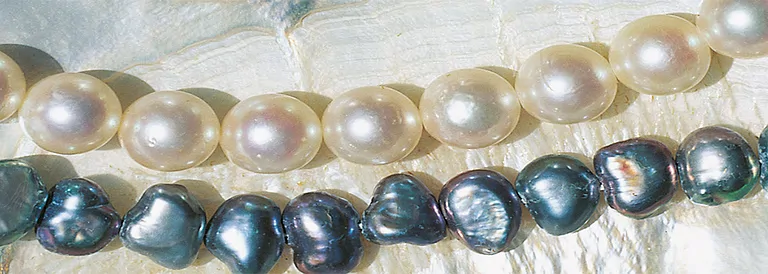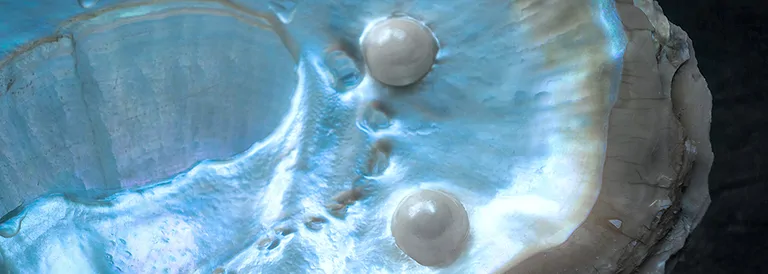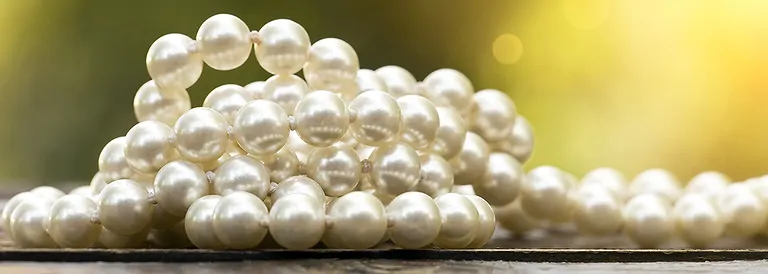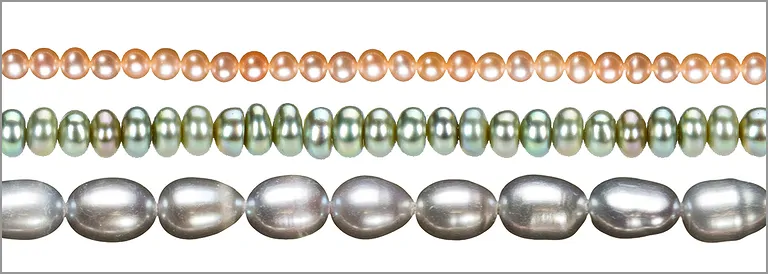
Pearls - Meaning and Effect
The shimmering pearl nurtures the soul and the emotional world. It helps to find and maintain emotional balance. Intuition and sensitivity is strengthened and it is possible to discover a rich inner imagery and to use it creatively.
From time immemorial, pearls have also been associated with tears. Tears are an expression of mourning and only mourning makes it possible to let go of what has been lost and what has passed, so that there is no standstill and the flow of life can continue unhindered. Beads can help to live through and transform grief, pain and loss more easily. So difficult times can overcome more easily and there is room for a new beginning.
In many cultures, the pearl was also worn very early as a piece of jewelry, since they - quite unlike gemstones - do not need to be processed. Pearls are not among the precious stones, they are products of oysters and some species of shells. They are formed naturally when the mollusk has to deal with a foreign body that has entered its interior. In order not to injure itself, the mollusk forms layer by layer a protective coat of Mother of Pearl around this "intruder" and thus arises a pearl in the course of several years. Analogous to this emergence, pearls can assist in addressing and resolving unprocessed conflicts. Just as the shell protects its vulnerable interior by a hard shell, the pearl reinforces the desire for retreat, internalization and coziness, especially in difficult situations.
Stringed beads of perals for jewelry, jewelry designer and bead stringer

Historical aspects of Pearls
Next to Gold and precious stones, pearls have always been indispensable status symbols in the treasuries of kings, princes and high church dignitaries. Since ancient times, pearls have been highly sought after <strong>to showcase wealth and prosperity</strong>. The Roman chronicler Pliny the Elder tells of Cleopatra's contest with her lover Marcus Antonius over who could host the most expensive banquet. The Egyptian queen had the idea not to score points with rare and exquisite food, but instead she took off one of her most precious pearls, which served her as ear jewelry, dissolved it in vinegar water and drank this strange concoction before Antony's eyes. Thus, she was sure to win the bet.
Value of Pearls
Quality and value of a pearl are determined by its luster, which is called "luster". The ideal pearl has a wonderful silky luster comparable to the light of the moon. Pearls come in a variety of colors, from white to pink, yellow, gold, greenish, blue, and the rare black specimens found only around Tahiti. At the same time, any pearl of the best quality should have a shade of pink in its color scale, as pink blends harmoniously with the colors of the complexion of the wearer of pearl jewelry. In addition to luster, the shape of the pearl is also an important quality criterion. The ideal shape is spherical, a shape that is rather rare in natural pearls. Irregularly shaped pearls are called "baroque pearls". A naturally grown pearl with good luster, above a certain size and in a spherical shape is a true rarity that trades more expensively than many gemstones. Individual specimens can achieve prices of several hundred thousand euros!
The majority of pearls on the market today are cultured pearls. In the twenties of the last century, it was the Japanese Kokichi Mikimoto, who was the first to succeed in creating artificial pearls by opening oysters, implanting them with foreign bodies and putting them back into the sea, so that in the course of about 3 to 5 years in this way the animal could coat the intruder with Mother of Pearl. The pearls obtained in this way are much more uniform in shape, size and quality than the rare natural pearls. They are therefore also more affordable in price.
Mother of Pearl jewelry (pendants, earrings, bracelets and more) at wholesale prices

Scientific profile of Pearls
Pearls consist of 3 - 4% water. During storage, it is important that this water does not dry out, otherwise the pearl loses its luster, it is also said that it "dies". Through contact with the skin, the water content of the pearl remains stable. However, care should be taken that pearls do not come into contact with detergents, cosmetics and perfume!
Varieties: A distinction is made between river pearls, seawater pearls and freshwater pearls.
The most sought-after and high-quality are the seawater pearls. River and freshwater pearls are smaller, do not have the noble luster of seawater pearls and rarely the coveted spherical shape.
Mineral Class: Calcium minerals, carbonates
Chemical Formula: CaCO3
Crystal System: rhombic (aragonite), trigonal (calcite)
Crystal form: microcrystalline aragonite flakes
Mohs hardness: 3 - 4
Cleavability: imperfect
Fracture: conchoidal
Color: white, pink, yellowish, reddish, silver, gold, bluish, black
Gloss: silky, iridescent
Appearance: Due to the shelly structure, pearls show round shapes, of which the spherical shape is the most desirable. Flat, half-round pearls are called button or button pearls, irregularly shaped pieces baroque pearls
Localities: South Seas, coastal areas of Japan and China, Australia, Polynesia, Sri Lanka, Central America and the Persian Gulf
Formation of Pearls
Pearls are formed in oyster-like marine and some freshwater mussels, when penetrated foreign bodies irritate the mucous membrane of the animal. Then they secrete the Mother of Pearl normally used to build the shell around the invaded foreign body. Based on the formation, pearls can be divided into natural pearls (natural nucleus, e.g., penetrated grain of sand) and cultured pearls (with nucleus or tissue particles inserted by humans). Another form is Shell Core Pearls, which are not naturally grown in the shell, but are cut from the shell itself and then enhanced with various shimmering coatings. The shell core pearls are usually perfectly round and are a fashionable and very affordable alternative to the very high priced South Sea pearls.
Stringed pearls for beading at retail prices

Classification of Pearls
Pearls can be distinguished on the basis of the water in which the pearl oysters live, in river pearls, seawater pearls and freshwater pearls:
River pearls: These pearls are formed by the river pearl oyster (Margaritifera margaritifera), which lives in the streams and rivers of the northern hemisphere, when their water is very clean and low in lime. River pearls are usually not quite round and very rarely grow larger than 20 mm.
Salt water/sea water pearls: This type of pearl is formed by inserting a nucleus in the form of a small polished sphere of Mother of Pearl. Therefore, the resulting pearls are usually "spherical". In the case of the pearls of mollusk species that live in the sea, the following variants are distinguished due to the geographical origin:
Tahitian pearls: The pearls of the pearl oyster (Pinctada margaritifera) come from the sea around the island of Tahiti. They are among the most sought-after pearls due to the natural, colorful iridescent dark colors and are about 8 to 16 mm in size. They are created by the insertion of a so-called nucleus, i.e. a foreign body inserted into the shell of the oyster, which is coated layer by layer by the mother of pearl oyster with mother of pearl.
South Sea Pearls: Indonesia, Australia and the Philippines are home to the pearl oyster (Pinctada maxima). Pearls of bright colors (white, silver and gold) grow around the nucleus to a typical maximum size of about 10 to 16 mm.
Akoya pearls: Originally, this name refers exclusively to pearls grown in the Sea of Japan in the Akoya pearl shell (Pinctada martensii and Pinctada fucata), but for some time Akoya pearls have also been grown in China, Tahiti and Vietnam. Typically, the pearls are 2 to 6 mm in size and white or cream in color, but can be readily dyed numerous other shades.
Keshi pearls: Keshi pearls ("poppy seed pearls") arise unplanned in shells in which Akoya South Sea or Tahitian pearls are cultured. They do not have a nucleus and are therefore natural pearls.
Because of the low price compared to saltwater pearls, freshwater pearls are very widely used. These pearls differ from other cultured pearls in that they are not nucleated. Instead, only a small incision is made in the tissue, into which a particle of tissue from another shell is inserted. Because there is no polished nucleus, freshwater pearls are rarely round, but are made entirely of Mother of Pearl and are bright and colorful. Freshwater pearls typically grow up to 14 mm in size and usually originate from China. This process also creates pearls in unusual shapes, such as a cross or a stick. A special form of freshwater pearl is the Biwa pearl from Lake Biwa in Japan. These are very high quality, as they have a strong luster, a smooth surface and a wide natural color spectrum.
With the popular freshwater cultured pearls, a wide range of colors is available in stores. The light shades (e.g. white, cream, ivory, salmon, light purple) are natural colors, for jewelry design, colored (e.g. petrol, chocolate, brown, green, copper) or bleached (pure white) are also popular.
Pearl jewelry (pendants, earrings, bracelets and more) for retailer